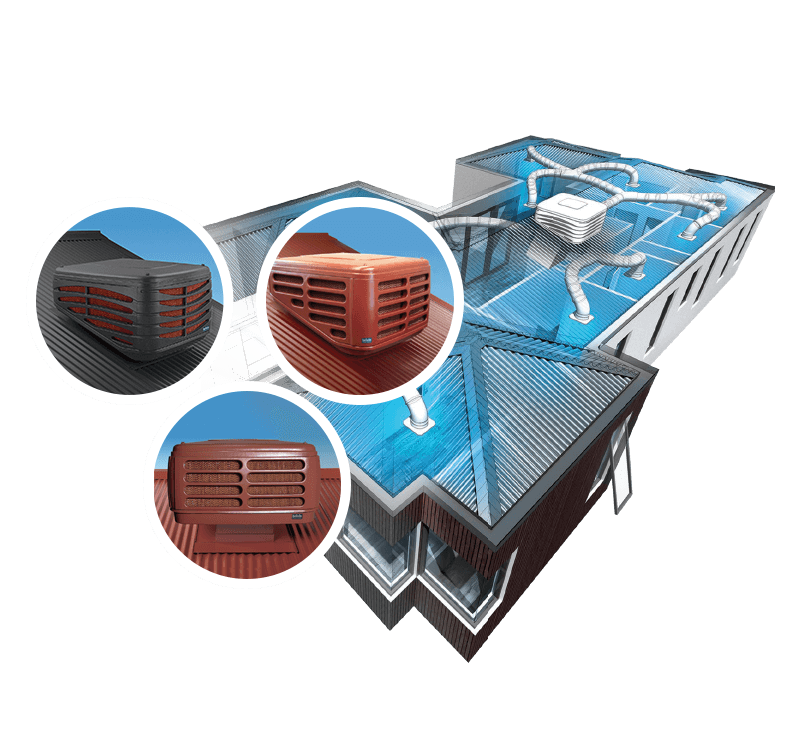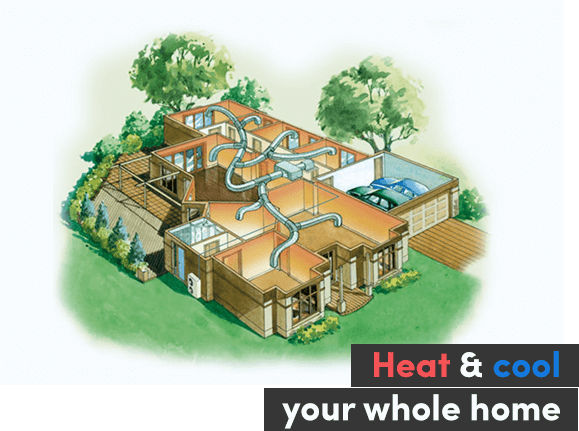
The effective way to cool your home
An evaporative cooler is essentially a large fan with water-moistened pads in front of it. The fan draws warm outside air through the porous pads and blows the now-cooled air throughout the house.
Small distribution lines supply water to the top of the pads. Water soaks the pads and, thanks to gravity, trickles through them to collect in a sump at the bottom of the cooler. A small recirculating water pump sends the collected water back to the top of the pads. Since water is continually lost through evaporation, a float valve – much like the one that controls the water in a toilet tank – adds water to the sump when the level gets low. Under normal conditions, an evaporative cooler can use between 3 to 15 gallons of water a day. A large fan draws air through the pads, where evaporation drops the temperature approximately 20 degrees. The fan then blows this cooled air into the house.
Normal air conditioning is a closed system, taking air from inside a house and recycling it. For air conditioning to function properly, doors and windows should be closed. Evaporative cooling, however, takes air from outside the house. For evaporative cooling to work properly the warm air inside your home must be allowed to escape, as it is pushed out the window by the new cooled air. By choosing which doors or windows in your home you leave open, you can to help direct the flow of cooled air to areas where it is needed.

The temperature of air coming out of an evaporative cooler obviously depends on the temperature and the humidity of the air going in. The main drawback of evaporative coolers is that they depend on dry outside air to operate effectively. On hot, muggy days in the summer, however, evaporative coolers will blow hot, humid, soggy air into the house.
In addition to the dropping the temperature of the air, evaporative cooling offers an additional cooling benefit. The constant movement of the air created by the blower – the cooling breeze it creates, if you will – makes the occupants of a room feel 4 to 6 degrees cooler than the actual temperature. This is the same effect you feel when you turn on a ceiling fan or a simple window fan. For this reason, the “effective temperature” created by an evaporative cooler will feel 4 to 6 degrees cooler than temperatures shown on the thermostat.
An added benefit of evaporative cooling is that it works best in the hottest time of the day. As the temperature outside increases as the sun climbs, the humidity normally drops, which makes evaporative cooling more effective.
For a swamp cooler to effectively cool, it must be the proper size for the job. A small unit will not adequately cool a large-sized house.
To ensure that your Evaporative cooler continues to operate at peak efficiency, it should be serviced at two year intervals by an authorised person trained in the service of coolers. Colbycool is authorised to service all evaporative coolers.
This service of the cooler unit will include all maintenance and adjustments required to the following components to ensure your cooler runs at its peak efficiency:
Please note that to maintain your warranty, many manufacturers now require regular servicing to be conducted by an authorised person trained in the service of Evaporative Coolers.

Get the latest special offers, news and more!